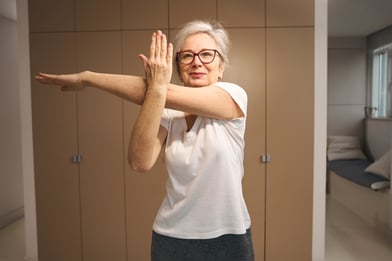 Anyone and everyone can benefit from having better balance. From professional athletes to the active aging population, balance plays a critical role in everyday life. Whether a professional gymnast is flipping on a beam, or a senior is simply trying to lower their risk of falling, improving balance starts with two things: identifying muscle imbalances and follows up with corrective exercise. The skeleton is put together in a way that encourages a steady base and equal weight distribution. This allows a person’s center of gravity to be right around the belly button. If a person has no muscle imbalances, their weight and center of gravity would be sitting directly above the pelvis. The hip bone then distributes that weight to each of the legs. In a perfect world that would mean the person’s knees would be directly below the hip joint and the ankle would be straight below the knee joint. The perfect world hardly exists, and muscle imbalances are the reason.
Anyone and everyone can benefit from having better balance. From professional athletes to the active aging population, balance plays a critical role in everyday life. Whether a professional gymnast is flipping on a beam, or a senior is simply trying to lower their risk of falling, improving balance starts with two things: identifying muscle imbalances and follows up with corrective exercise. The skeleton is put together in a way that encourages a steady base and equal weight distribution. This allows a person’s center of gravity to be right around the belly button. If a person has no muscle imbalances, their weight and center of gravity would be sitting directly above the pelvis. The hip bone then distributes that weight to each of the legs. In a perfect world that would mean the person’s knees would be directly below the hip joint and the ankle would be straight below the knee joint. The perfect world hardly exists, and muscle imbalances are the reason.
Every moving joint has a muscle origin point on either side of it. For example, the shoulder joint holds the origin points of the biceps brachii and triceps brachii muscles. If the biceps muscle is stronger or tighter than the triceps muscle, the shoulder joint will be pulled and rotated forward. Any muscle imbalance will cause a change in mass distribution, ultimately resulting in a new center of mass. The body will compensate for this by changing gait or shifting other joints into a position that will feel stable. Unfortunately, this new position is usually one that the joint is not meant to be in. Until the initial imbalances are corrected through training, more imbalances will occur. The longer someone waits to begin corrective exercise, the harder it will be to correct, and the likelihood of injury or sustained damage will increase.
When the skeleton is completely in balance, all the joints are aligned, and the body is in its most stable position. Recognizing these imbalances are important, especially with the active aging community. The most common shifts in the skeleton are:
- Anterior Pelvic Tilt (when the pelvis is rotated forward)
- Excessive Kyphotic Posture (rounded back/shoulders)
- Internal Rotation of the Shoulders (which can cause shoulder injury)
And all these deviations will not only cause pain, but a shift in someone’s center of balance. Being mindful of these imbalances and working on correcting them as soon as possible are very important. Corrective exercise will allow someone to achieve better balance while also relieving the pain caused by the skeletal shifts. With every muscle imbalance, there is a tight muscle and a weak antagonist muscle. Both issues should simultaneously be worked on to correct the imbalance.
Ways of releasing the tight muscle temporarily include:
- Soft Tissue Massage
- Foam Rolling
- Stretching
Ways of strengthening the weak muscle for long term correction include:
- Moving the Joint
- Isolation Exercises
- Isometric Contractions
Including any combination of these in an exercise program will help alleviate those muscle imbalances, providing pain relief and better balance. Consider scheduling an assessment with a fitness professional to have these possible imbalances identified and exercise prescribed to help!


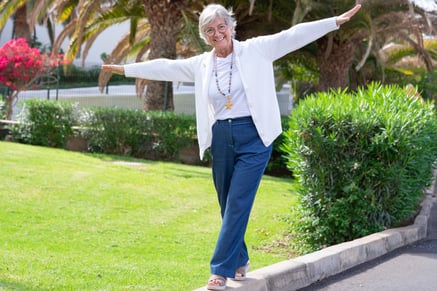 What is great about practicing balance is there are multiple ways to do so without breaking the bank. In
What is great about practicing balance is there are multiple ways to do so without breaking the bank. In 
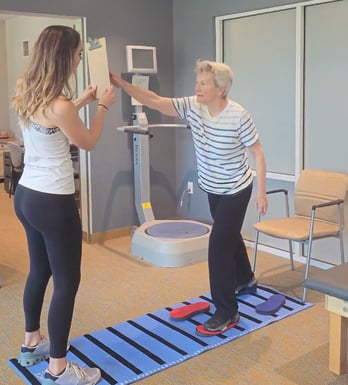 What is great about practicing balance is that there are multiple ways to do it including the utilization of various machines. Within senior living, evaluating equipment options can be a helpful starting point to developing a comprehensive fall prevention program for residents. In this two-part blog series, we’ll be covering investment pieces to incorporate in your fitness center’s fall prevention programming as well as more budget-friendly options if you are looking for more cost-effective options to give your
What is great about practicing balance is that there are multiple ways to do it including the utilization of various machines. Within senior living, evaluating equipment options can be a helpful starting point to developing a comprehensive fall prevention program for residents. In this two-part blog series, we’ll be covering investment pieces to incorporate in your fitness center’s fall prevention programming as well as more budget-friendly options if you are looking for more cost-effective options to give your 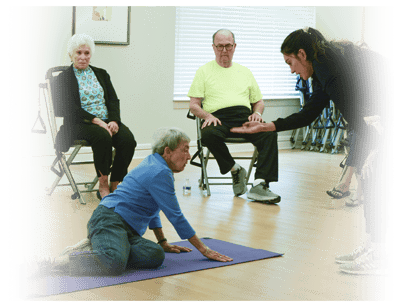 Fall prevention programs and services have been a cornerstone of
Fall prevention programs and services have been a cornerstone of 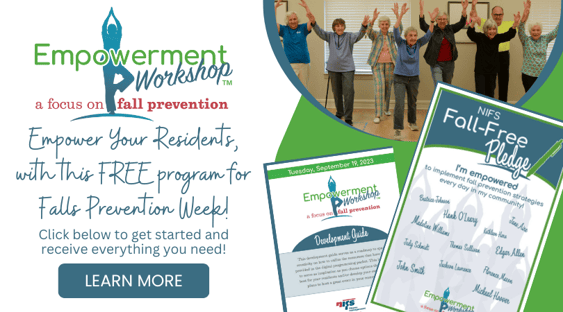
 A vacation is great to “get away from it all.” It is up to you if that includes your normal exercise routine. Most of the research indicates that one week off from exercising will not take away from the progress you have made. In some instances, a week off can increase your performance by allowing lingering injuries time to heal. More than one week off can lead to declines in cardiovascular and muscular ability. During your vacation take these steps to not lose the progress you have made.
A vacation is great to “get away from it all.” It is up to you if that includes your normal exercise routine. Most of the research indicates that one week off from exercising will not take away from the progress you have made. In some instances, a week off can increase your performance by allowing lingering injuries time to heal. More than one week off can lead to declines in cardiovascular and muscular ability. During your vacation take these steps to not lose the progress you have made.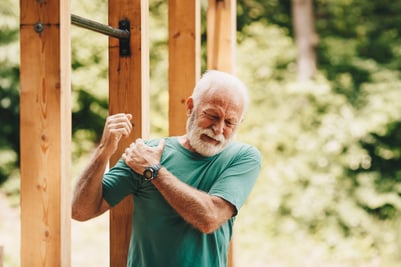 “No Pan, No Gain”
“No Pan, No Gain”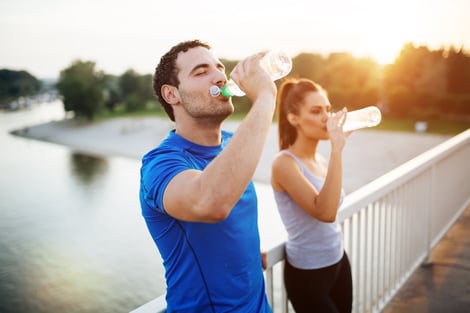 With the warmer summer months, it's the most prominent time when dehydration can become a big health issue and roadblock, especially if you are exercising outdoors. The heat and humidity can make it difficult to maintain a healthy balance of fluids in the body. That's why staying hydrated is not only important for your health but also for your fitness goals.
With the warmer summer months, it's the most prominent time when dehydration can become a big health issue and roadblock, especially if you are exercising outdoors. The heat and humidity can make it difficult to maintain a healthy balance of fluids in the body. That's why staying hydrated is not only important for your health but also for your fitness goals. .jpg?width=472&height=314&name=GettyImages-910975942%20(1).jpg) Enthusiasm is very important in the fitness world. As fitness leaders in the community, it is our job and our responsibility to set the tone for our residents and clients. Imagine coming in for a fitness class or a personal training session and your trainer is not energetic at all. It almost seems like they don’t even want to be there. How can you expect to be excited about your workout if your trainer isn’t? Energy, whether it is good or bad, is contagious. Our job as fitness professionals is to get people excited to workout. The best way we can do this is by increasing our own enthusiasm. If we are excited about their workout, then they will be excited too.
Enthusiasm is very important in the fitness world. As fitness leaders in the community, it is our job and our responsibility to set the tone for our residents and clients. Imagine coming in for a fitness class or a personal training session and your trainer is not energetic at all. It almost seems like they don’t even want to be there. How can you expect to be excited about your workout if your trainer isn’t? Energy, whether it is good or bad, is contagious. Our job as fitness professionals is to get people excited to workout. The best way we can do this is by increasing our own enthusiasm. If we are excited about their workout, then they will be excited too.
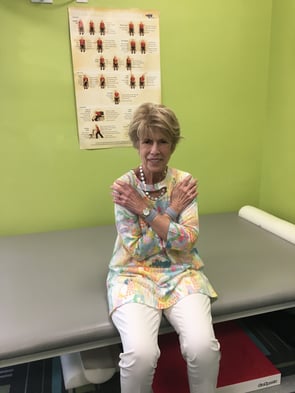 It is not uncommon that group fitness classes tend to be the bread and butter of a community’s fitness program. Classes provide so many benefits including guided exercises,
It is not uncommon that group fitness classes tend to be the bread and butter of a community’s fitness program. Classes provide so many benefits including guided exercises, 
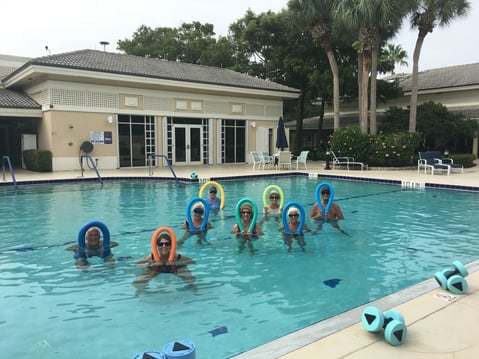 When you were a kid, going out to play was something you likely did every day. No matter if it was riding a bike, skipping rocks at the pond, or running around the neighborhood with friends, it was just fun! Moving came naturally and easy and was not considered “exercise” to the adolescent mind even though it was most certainly keeping your body healthy. The reason I bring this up is because I want you to think about those times. They were a lot of fun, weren’t they? Sometimes in our fitness center, we will hear a member say that exercise isn’t very fun. We get it! Exercise isn’t everyone’s cup of tea, but as a fitness professional, my goal is to find a way to make it fun for you. Another thing we will often here is “I’m not as young as I was!” or “I can’t do that type of movement anymore.” It is true, with the play you did as a child, there was probably a lot of falling, bumps, and bruises and that can make a person apprehensive to get started in “play” again. But that is why we are here, to explore with you and find a form of fitness that you enjoy. Yes, the several number of changes that tend to happen to the body as it goes through the stages of life can make some things more difficult, but we want to help keep it from being the reason you decide to play less.
When you were a kid, going out to play was something you likely did every day. No matter if it was riding a bike, skipping rocks at the pond, or running around the neighborhood with friends, it was just fun! Moving came naturally and easy and was not considered “exercise” to the adolescent mind even though it was most certainly keeping your body healthy. The reason I bring this up is because I want you to think about those times. They were a lot of fun, weren’t they? Sometimes in our fitness center, we will hear a member say that exercise isn’t very fun. We get it! Exercise isn’t everyone’s cup of tea, but as a fitness professional, my goal is to find a way to make it fun for you. Another thing we will often here is “I’m not as young as I was!” or “I can’t do that type of movement anymore.” It is true, with the play you did as a child, there was probably a lot of falling, bumps, and bruises and that can make a person apprehensive to get started in “play” again. But that is why we are here, to explore with you and find a form of fitness that you enjoy. Yes, the several number of changes that tend to happen to the body as it goes through the stages of life can make some things more difficult, but we want to help keep it from being the reason you decide to play less.